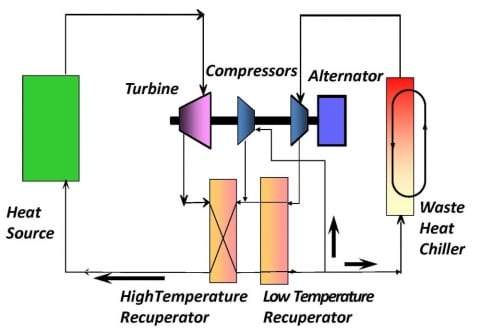Supercritical CO2 Brayton Power Cycle Pilot Plant Bolstered with $80M in Federal Funding
The Department of Energy's National Energy Technology Laboratory (NETL) will award up to $80 million to a 10-MWe pilot project that seeks to advance the development and commercialization of supercritical carbon dioxide (sCO2) Brayton power cycles.
The plant will be managed by three research entities: the Gas Technology Institute (GTI), Southwest Research Institute (SwRI), and GE Global Research. GTI will design, build, commission, and operate the sCO2 pilot facility located at SwRI's campus in San Antonio, Texas.
sCO2 Brayton power cycles operate in a manner similar to other turbine cycles, but their high-power-density turbomachinery uses sCO2 as the working fluid.
 Recompression closed Brayton cycle schematic diagram. Source: DOE
Recompression closed Brayton cycle schematic diagram. Source: DOEAccording to the DOE, no commercially feasible sCO2 facility exists for high temperature and high-efficiency system testing, even though the technology has been under development for decades.
Closed power-generating Brayton cycles (using air as a working fluid) have been around since the 1930s, when the first of a series of plants began using the technology. Until the 1970s, closed Brayton units operated on several energy sources, including coal, gas, and waste heat. As GTI noted in a statement, Brayton power cycles have also been used in spacecraft applications where compact, lightweight, high-energy-density power conversion is required.
"These advantages are now being applied to terrestrial power generation for the step-change increase in efficiency and corresponding reduction in emissions they offer," it added.
sCO2 is a fluid state of carbon dioxide where it is held at or above its critical temperature and critical pressure. As NETL explains on its website: "Carbon dioxide usually behaves as a gas in air at standard temperature and pressure (STP), or as a solid called dry ice when frozen. If the temperature and pressure are both increased from STP to be at or above the critical point for carbon dioxide, it can adopt properties midway between a gas and a liquid. At this state, sCO2 can be used efficiently throughout the entire Brayton cycle."
 Critical point. Supercritical carbon dioxide is a fluid state of carbon dioxide where it is held at or above its critical temperature and critical pressure. Source: DOE
Critical point. Supercritical carbon dioxide is a fluid state of carbon dioxide where it is held at or above its critical temperature and critical pressure. Source: DOENETL said that the average efficiency of the U.S. fleet of steam Rankine cycle power plants is in the lower 30% range. "This new facility has the potential to demonstrate greater than 50 percent cycle efficiency. If successfully developed, the supercritical CO2 power cycles could provide significant efficiency gains in geothermal, coal, nuclear, and solar thermal power production," it said.
 A size benefit. The DOE suggests that supercritical carbon dioxide Brayton cycles have a number of advantages over Rankine cycles. Source: DOE
A size benefit. The DOE suggests that supercritical carbon dioxide Brayton cycles have a number of advantages over Rankine cycles. Source: DOEThe 10-MWe pilot plant will operate at a turbine inlet temperature of at least 700C. The project will aim to advance the "state-of-the-art high-temperature sCO2 power cycle performance from proof-of-concept to a validated prototype operational system," GTI said.
The company said that over the last decade, its staff-which was formerly with Aerojet Rocketdyne, a company GTI acquired in 2015-has conducted much work in sCO2 technology, including for cycle modeling and optimization, economic evaluations, advanced materials characterization, and design studies of key components (such as turbines, compressors, and recuperators).
In early 2016, GTI completed conceptual plans to support the design, cost, and schedule for the 10 MWe sCO2 Brayton Cycle test facility with funding from U.S. DOE's Office of Nuclear Energy, in cooperation with the Office of Fossil Energy, and the Office of Energy Efficiency and Renewable Energy.
"The project will address the research and development needs of the component vendors and support the risk reduction and commercialization needs of the systems integrators and end users," GTI said. "Developing and maturing the technology at pilot scale will spur the development of necessary equipment, understanding, and characterization needed for larger-scale sCO2 power conversion systems."
-Sonal Patel, associate editor (@POWERmagazine, @sonalcpatel)
The post Supercritical CO2 Brayton Power Cycle Pilot Plant Bolstered with $80M in Federal Funding appeared first on POWER Magazine.